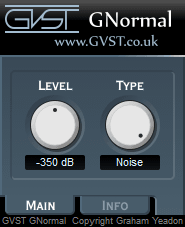GVST GNormal
Inaudible noise generator for preventing denormals - free VST audio effect plug-in download for music production, broadcasting and general audio editing.
- Floating point calculations can slow down dramatically when numbers get very small.
- Some plug-ins can be negatively affected by this.
- Adding this plug-in to the effects chain ahead of problem plug-ins can solve the problem.
For more details, read through the online manual below.
GNormal Manual
Welcome to GNormal
GNormal tries to remedy denormal problems by introducing extremely low-level noise to the signal path.
(If you don't know what that means, then you probably don't need GNormal).
Some CPUs employ techniques to extend the accuracy of floating-point calculations involving very small numbers.
These small numbers are called denormals.
Unfortunately, calculations involving denormals can be very slow, drastically affecting audio DSP performance; and in most cases the numbers involved are too small to be of any interest anyhow.
Adding noise to the signal path can prevent denormals from reaching subsequent calculations by keeping the signal level above the denormal range.
The level of the noise added is so low that it is inaudible.
Interface

The GNormal user interface has two knobs to control the two parameters.
Level: The maximum peak level of the generated noise.
Type: The type of noise generated.
Some noise types are ineffective in particular circumstances.
For example, "AC" noise will be removed by a low-pass filter.
The only way of knowing which will work for a given plug-in is by trying them.
- DC: A constant value is added to the signal.
- AC: Like DC except that the sign of the added value flips every sample.
- Square: Like AC except that the sign flips less frequently, forming a square wave shape.
- Pulse: Occasionally adds a single value at the set level followed by zeroes.
- Noise: Adds white noise to the signal.
Hints and ideas
-
The simplest way to configure GNormal is to place it before a suspect plug-in and set the "Level" parameter to maximum.
Try each setting of the "Type" parameter to see if the problem goes away.
When you have found a suitable noise-type, you should reduce the noise-level as much as possible.

